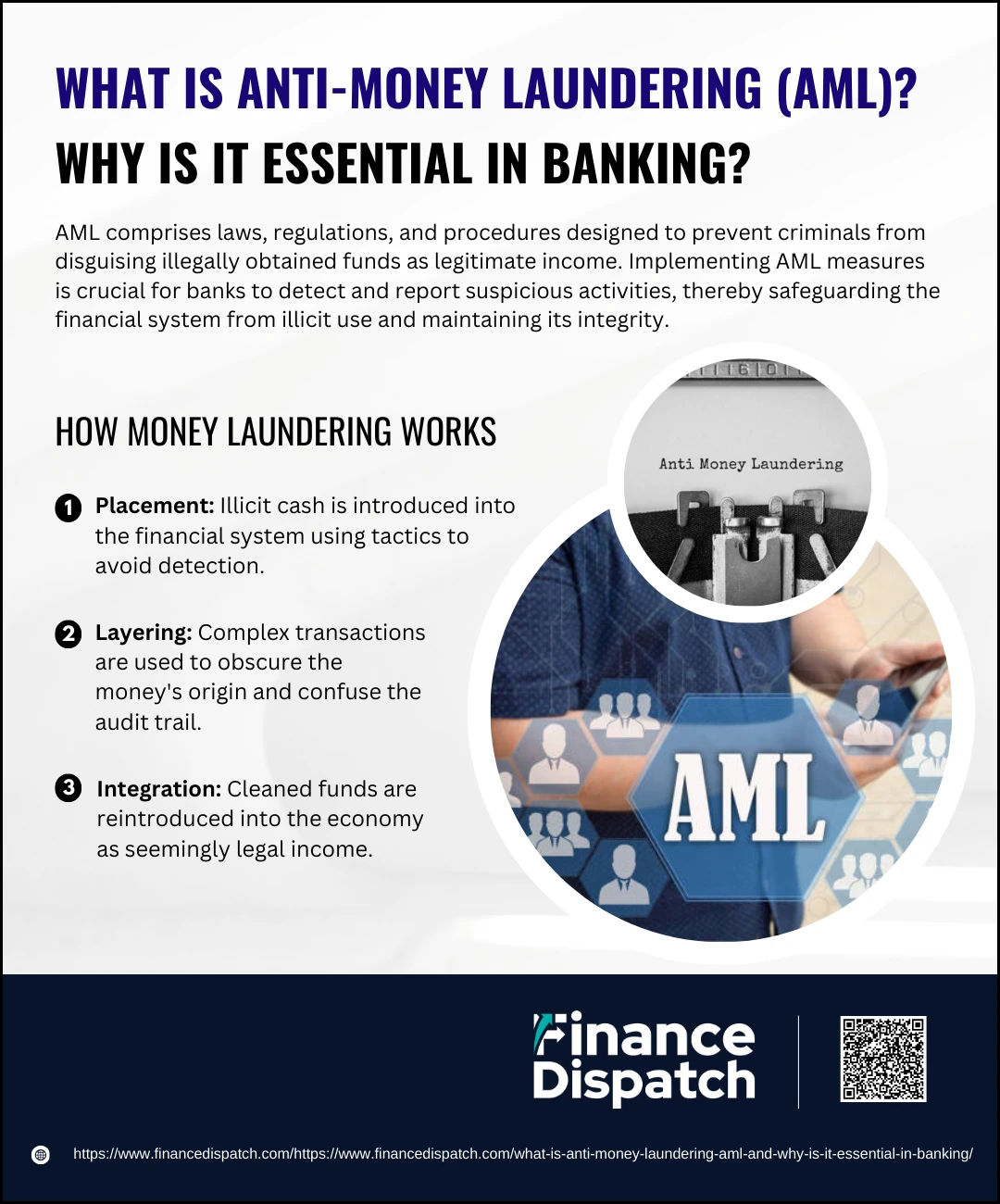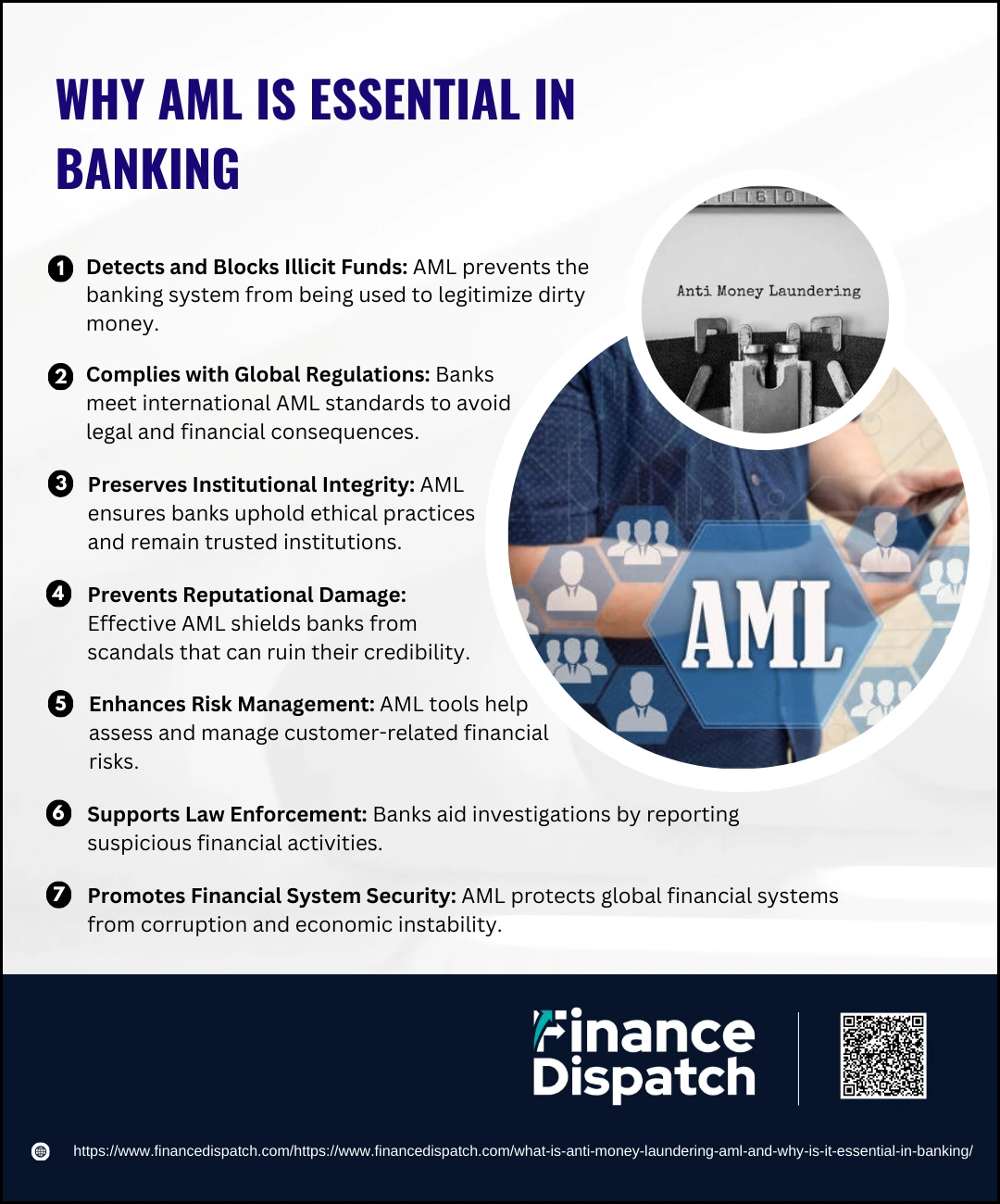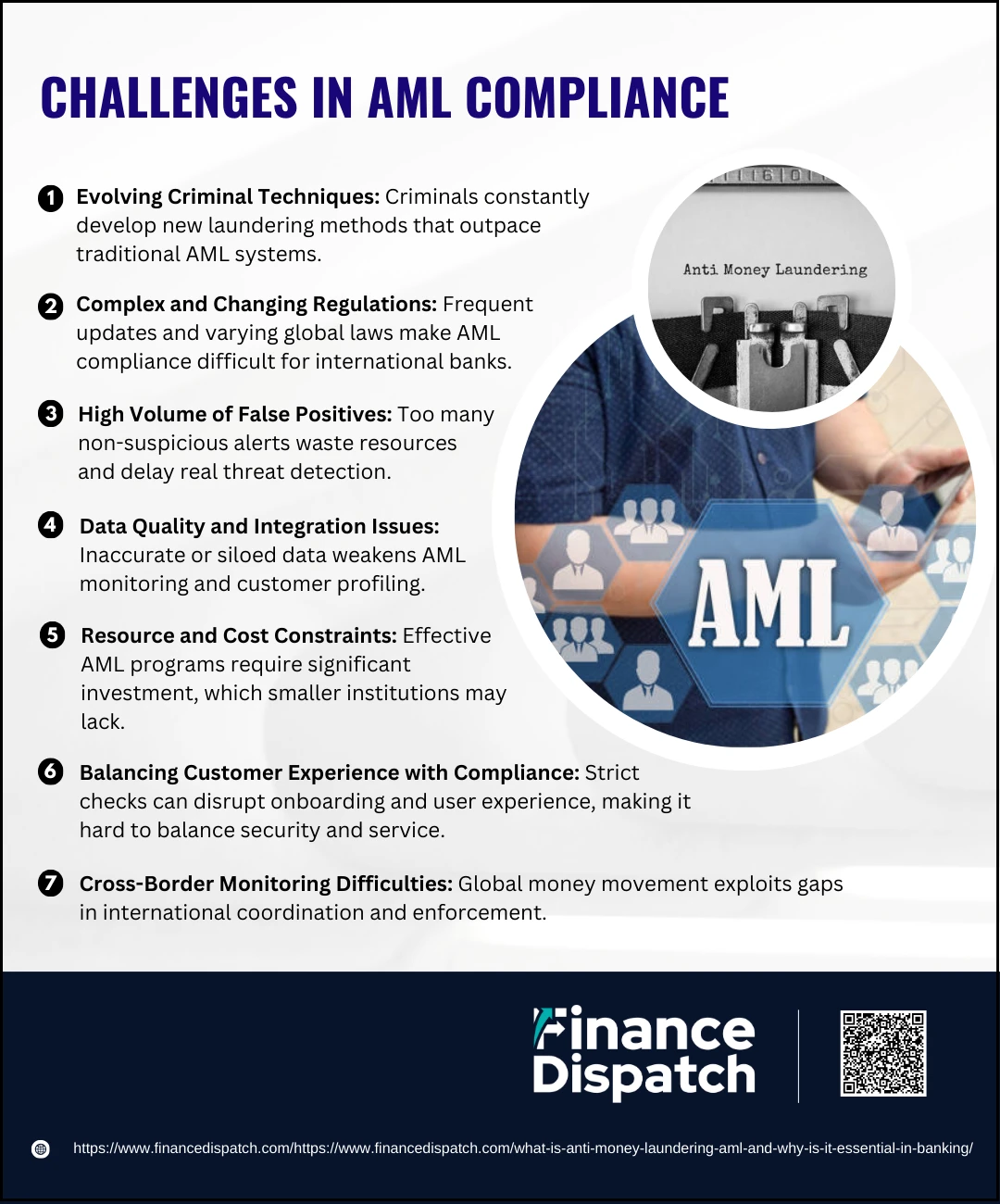In today’s complex financial world, preventing illicit activities has become a top priority for banks and financial institutions. One of the most significant threats they face is money laundering—a process by which criminals disguise the origins of illegally obtained money to make it appear legitimate. To combat this, a framework known as Anti-Money Laundering (AML) has been established, encompassing a range of laws, regulations, and procedures designed to detect and deter financial crimes. AML is not just a regulatory requirement—it’s a crucial safeguard for maintaining the integrity of the banking system, protecting institutions from reputational damage, and ensuring global financial stability. This article explores what AML really means and why it plays such a vital role in modern banking.
What is Anti-Money Laundering (AML)?
Anti-Money Laundering (AML) refers to a set of laws, regulations, and practices designed to prevent criminals from disguising illegally obtained funds as legitimate income. It encompasses the policies and procedures that financial institutions must implement to detect suspicious transactions, verify customer identities, and report potential money laundering activities to relevant authorities. AML efforts aim to break the chain of financial crime by identifying and interrupting the flow of illicit money at every stage of its laundering cycle. These measures not only help curb criminal enterprises such as drug trafficking, terrorism financing, and corruption but also ensure the integrity and trustworthiness of the global financial system.
 How Money Laundering Works
How Money Laundering Works
Money laundering allows criminals to conceal the origins of their illicit funds and use them without attracting suspicion. This process enables illegal profits to be integrated into the legitimate economy, making it harder for authorities to trace the money back to its criminal source. While techniques may vary, most laundering schemes follow a common three-step process: Placement, Layering, and Integration.
1. Placement
Placement is the initial and most vulnerable stage of the money laundering cycle. Here, the objective is to introduce the “dirty” money into the financial system without drawing attention. Because large cash transactions can raise red flags, criminals often use tactics such as depositing small amounts across multiple accounts (a technique known as “smurfing”), purchasing high-value goods like jewelry or art, or funneling money through cash-intensive businesses such as restaurants, casinos, or retail stores. The key goal during placement is to move the illicit cash into the financial system in a way that avoids detection and reporting.
2. Layering
Layering involves creating a complex web of financial transactions to hide the audit trail and disguise the origin of the money. At this stage, the launderer may transfer funds between several accounts (often in different countries), invest in financial instruments, or convert money into various currencies or cryptocurrencies. These actions are meant to “layer” the funds in such a way that tracing their original source becomes extremely difficult. This stage often involves the use of shell companies, offshore accounts, and intermediaries to further blur the connection between the criminal and the money.
3. Integration
In the final stage, the laundered funds re-enter the mainstream economy appearing to be legitimate income. This makes it difficult for law enforcement agencies to link the money back to its criminal roots. The funds may be invested in legal businesses, used to purchase real estate, luxury vehicles, or even donated to charitable organizations. At this point, the money can be used openly with minimal risk of detection, having been successfully cleaned through the prior stages.
 The Importance of AML in Banking
The Importance of AML in Banking
In the modern financial landscape, banks are central players not only in economic development but also in safeguarding the integrity of global finance. With their broad access to funds and international transactions, banks are prime targets for criminals seeking to launder money from illicit activities. This is where Anti-Money Laundering (AML) frameworks become vital. AML programs equip banks with tools to detect suspicious behavior, reduce exposure to financial crime, and uphold the rule of law. Far from being a regulatory formality, AML is essential to preserving public trust and supporting the fight against organized crime and terrorism.
1. Prevents Financial Crimes
AML protocols are designed to identify and block transactions linked to criminal activities such as drug trafficking, human smuggling, corruption, and terrorist financing. By monitoring customer behavior and transactional patterns, banks can flag unusual or high-risk activities before funds are fully laundered, effectively disrupting criminal enterprises.
2. Ensures Regulatory Compliance
Banks must adhere to national and international laws such as the USA PATRIOT Act, the Bank Secrecy Act, and directives issued by global bodies like the Financial Action Task Force (FATF). Non-compliance can lead to heavy financial penalties, restrictions on operations, and reputational damage. AML programs help institutions stay compliant and demonstrate their commitment to ethical standards.
3. Protects Bank Reputation
A bank linked to money laundering, even unintentionally, may suffer long-term reputational harm. Negative publicity can erode customer confidence and trigger a loss of clients, partners, and investors. Strong AML systems act as a shield, minimizing the risk of becoming entangled in financial scandals.
4. Maintains Financial System Stability
When dirty money flows through the banking system unchecked, it distorts financial markets and can fuel economic instability. AML frameworks ensure transparency and accountability, creating a safer environment for economic transactions and long-term investment.
5. Supports Law Enforcement and Investigations
Banks are legally required to report suspicious transactions through Suspicious Activity Reports (SARs). These reports provide law enforcement agencies with vital leads and data, helping them trace illicit money trails, freeze assets, and prosecute offenders.
6. Enhances Customer Due Diligence (CDD)
AML compliance begins with knowing the customer. Through robust Know Your Customer (KYC) procedures, banks verify identities, assess risk levels, and detect red flags early. This ensures that the bank is not unknowingly serving individuals or entities involved in illicit conduct.
 Why AML is Essential in Banking
Why AML is Essential in Banking
Banks are pillars of the global economy, responsible for facilitating trillions of dollars in transactions every day. However, their vast networks and access to money also make them prime targets for exploitation by criminals seeking to clean dirty money. Anti-Money Laundering (AML) measures serve as the backbone of financial defense, designed to detect, prevent, and report suspicious activity before it becomes a larger threat. For banks, AML is not just a checkbox for compliance—it’s a fundamental component of trust, accountability, and long-term success. Below are the main reasons why AML is indispensable in the banking sector:
1. Detects and Blocks Illicit Funds
One of the primary purposes of AML is to prevent criminals from using the banking system to legitimize proceeds from illegal activities such as drug trafficking, fraud, terrorism financing, and corruption. Through monitoring tools and customer due diligence, banks can flag suspicious transactions and stop illicit funds from blending into the legitimate economy.
2. Complies with Global Regulations
Banks operate under strict national and international AML regulations enforced by agencies such as the Financial Action Task Force (FATF), the European Union, and the U.S. Treasury Department. Failure to comply can result in multi-million dollar fines, operational restrictions, or even closure. AML systems help banks meet these legal obligations efficiently and avoid regulatory consequences.
3. Preserves Institutional Integrity
A bank’s reputation is built on trust and transparency. Effective AML measures ensure that the institution does not become an unwitting participant in criminal enterprises. This reinforces the bank’s ethical standards and safeguards its integrity in the eyes of customers, investors, and regulators.
4. Prevents Reputational Damage
When banks are linked to money laundering cases, the fallout is not limited to fines. The reputational harm can lead to a loss of business, decline in stock prices, and even bankruptcy in extreme cases. AML controls serve as a frontline defense against becoming embroiled in scandals that can ruin a bank’s image.
5. Enhances Risk Management
AML frameworks include processes like Know Your Customer (KYC), Customer Due Diligence (CDD), and risk profiling. These tools allow banks to better understand who their clients are, assess their risk levels, and tailor their monitoring accordingly. This leads to smarter, more proactive decision-making in managing financial and operational risks.
6. Supports Law Enforcement
Banks play a vital role in fighting financial crime by reporting Suspicious Activity Reports (SARs) and collaborating with law enforcement agencies. This cooperation helps in tracking criminal networks, freezing illicit assets, and prosecuting offenders—making AML not just a banking responsibility but a public good.
7. Promotes Financial System Security
At a broader level, AML efforts help ensure that the global financial system is not compromised by dirty money. Clean financial systems encourage international trade, foreign investment, and economic stability, while deterring threats that could lead to inflation, corruption, or political instability.
Key Components of an Effective AML Program
An effective Anti-Money Laundering (AML) program is essential for any financial institution aiming to detect and prevent financial crime. It serves as a structured framework that guides banks and other regulated entities in identifying suspicious activities, mitigating risks, and complying with legal requirements. While the core goal remains the same—keeping illicit funds out of the financial system—successful AML programs rely on several interrelated components working together in harmony. The table below outlines the key elements of a robust AML program and their respective roles.
| Component | Description |
| Customer Due Diligence (CDD) | The process of verifying a customer’s identity, understanding their financial behavior, and assessing risk levels to prevent criminal infiltration. |
| Know Your Customer (KYC) | A fundamental part of CDD that includes collecting and verifying personal information before establishing a business relationship. |
| Transaction Monitoring | Ongoing surveillance of customer transactions to identify patterns or anomalies that may indicate money laundering or suspicious activity. |
| Suspicious Activity Reporting (SAR) | The formal process of reporting unusual or potentially illicit transactions to regulatory or enforcement authorities for further investigation. |
| Risk Assessment | Regular evaluation of institutional risk exposure based on customer types, geographies, products, and services to apply appropriate controls. |
| Internal Controls and Policies | Clearly documented policies, procedures, and governance structures to ensure consistent and effective AML compliance across the organization. |
| Training and Awareness | Continuous education for staff to recognize red flags and understand AML responsibilities and procedures. |
| Independent Audit Function | A periodic, unbiased review of the AML program’s effectiveness to ensure compliance and recommend improvements. |
| Recordkeeping | Proper documentation and retention of customer data and transaction records to support investigations and audits. |
Global and US AML Regulatory Bodies
Anti-Money Laundering (AML) efforts are coordinated by various regulatory bodies around the world, each playing a vital role in enforcing standards, issuing guidelines, and ensuring compliance within financial institutions. These organizations work together to build a transparent global financial system capable of detecting and deterring money laundering and related crimes. Both international and U.S.-based bodies contribute to shaping the regulatory landscape, setting the framework within which banks and financial entities must operate.
Key Global AML Regulatory Bodies:
1. Financial Action Task Force (FATF): An intergovernmental organization that sets international standards to combat money laundering and terrorist financing. It issues recommendations followed by over 200 countries and jurisdictions.
2. Basel Committee on Banking Supervision (BCBS): Provides global banking guidelines, including principles for effective risk management and AML practices in banks.
3. Egmont Group: A network of Financial Intelligence Units (FIUs) from around the world that facilitates the exchange of information and collaboration in fighting financial crimes.
4. United Nations Office on Drugs and Crime (UNODC): Offers global assistance and technical support to countries to help develop AML policies and address transnational organized crime.
Key U.S. AML Regulatory Bodies:
1. Financial Crimes Enforcement Network (FinCEN): A bureau of the U.S. Department of the Treasury responsible for collecting and analyzing financial transaction data to combat money laundering and related crimes.
2. Office of Foreign Assets Control (OFAC): Enforces economic and trade sanctions and prohibits transactions with sanctioned individuals, organizations, and countries.
3. Federal Reserve System (The Fed): Oversees AML compliance within U.S. banks and enforces relevant banking laws.
4. Office of the Comptroller of the Currency (OCC): Regulates and supervises national banks and federal savings associations to ensure sound AML compliance.
5. Securities and Exchange Commission (SEC): Monitors AML practices within securities firms and investment companies.
6. Federal Deposit Insurance Corporation (FDIC): Supervises state-chartered banks and ensures they meet AML obligations.
Real-World Examples of AML Failures in Banking
Despite the presence of strong regulations and frameworks, history has shown that many financial institutions have failed to implement effective Anti-Money Laundering (AML) measures. These failures have led to serious consequences, including massive fines, loss of reputation, and increased regulatory scrutiny. Examining real-world examples helps underscore the importance of robust AML compliance and highlights the risks banks face when systems break down or are deliberately ignored.
Notable AML Failures in the Banking Sector:
1. HSBC (2012)
HSBC was fined $1.9 billion by U.S. authorities for allowing drug traffickers in Mexico and other countries to launder billions of dollars through its U.S. operations. The bank admitted to having poor AML controls and failing to monitor over $670 billion in wire transfers.
2. Danske Bank (2018)
This Danish bank became involved in one of Europe’s largest money laundering scandals, where over €200 billion of suspicious transactions flowed through its Estonian branch between 2007 and 2015. The case exposed severe deficiencies in AML oversight and internal controls.
3. Standard Chartered (2019)
The UK-based bank paid $1.1 billion in fines to U.S. and UK authorities for AML breaches related to inadequate monitoring of transactions, some of which were tied to sanctioned entities in countries like Iran and Syria.
4. Wachovia Bank (2010)
Before its merger with Wells Fargo, Wachovia was found to have processed $378 billion for Mexican currency exchange houses. The bank failed to apply proper AML checks, enabling drug cartels to move massive sums through its accounts.
5. Westpac Bank (2020)
One of Australia’s largest banks, Westpac was fined AU$1.3 billion for violating AML laws, including failures to report over 23 million international transactions. Some of the transactions were linked to child exploitation networks.
 Challenges in AML Compliance
Challenges in AML Compliance
As financial crimes become more sophisticated, so do the challenges faced by banks and financial institutions in maintaining effective Anti-Money Laundering (AML) compliance. Staying ahead of evolving criminal tactics, complying with global regulations, and managing operational costs all contribute to a complex compliance landscape. Even with advanced technology and strict policies, many institutions struggle to keep their AML programs efficient, accurate, and up-to-date. Below are some of the most pressing challenges in AML compliance today:
1. Evolving Criminal Techniques
Money launderers continuously develop new tactics to bypass detection, including the use of shell companies, cryptocurrencies, and digital banking channels. This constant innovation makes it difficult for static AML systems to keep up.
2. Complex and Changing Regulations
Regulatory expectations vary across jurisdictions and are frequently updated. Banks operating internationally must navigate overlapping laws and comply with multiple standards, which increases compliance complexity.
3. High Volume of False Positives
AML systems often generate numerous alerts, many of which are not truly suspicious. Reviewing these false positives requires significant time and resources, reducing efficiency and delaying the detection of real threats.
4. Data Quality and Integration Issues
Poor data quality or siloed systems can result in incomplete customer profiles and weak monitoring capabilities. Effective AML depends on unified, accurate, and accessible data across all departments and platforms.
5. Resource and Cost Constraints
Building and maintaining an AML program is resource-intensive. Smaller banks may lack the financial and human resources to implement sophisticated AML technologies or hire experienced compliance personnel.
6. Balancing Customer Experience with Compliance
Strict AML checks can create friction in the customer onboarding process or delay legitimate transactions. Finding a balance between rigorous compliance and seamless customer service remains a significant challenge.
7. Cross-Border Monitoring Difficulties
Criminals often move money across borders to exploit gaps in international cooperation. Differences in regulatory enforcement and information-sharing hinder the global fight against money laundering.
The Future of AML in Banking
The future of Anti-Money Laundering (AML) in banking is being shaped by rapid technological advancements, increased regulatory expectations, and a growing emphasis on global collaboration. As financial criminals adopt more sophisticated methods, banks are turning to artificial intelligence (AI), machine learning, and big data analytics to enhance their AML capabilities. These technologies enable faster detection of complex patterns and reduce false positives, making compliance more efficient and proactive. Additionally, regulators are pushing for greater transparency, real-time monitoring, and integrated risk management systems. Collaboration between financial institutions, governments, and international organizations will also be key in creating a unified response to cross-border money laundering threats. As AML evolves, it will not only become more technology-driven but also more predictive, adaptive, and collaborative—ensuring a stronger defense against financial crime in the digital age.
Conclusion
Anti-Money Laundering (AML) is more than just a regulatory obligation—it’s a critical component of maintaining trust, transparency, and stability in the banking industry. As financial crime becomes more advanced and globalized, the importance of strong AML frameworks cannot be overstated. From protecting institutions against reputational and financial damage to supporting law enforcement in the fight against crime, AML plays a vital role at every level. By investing in robust compliance programs, leveraging technology, and fostering global cooperation, banks can not only safeguard their operations but also contribute to the broader goal of securing the financial system against illicit activity.



